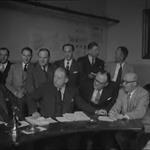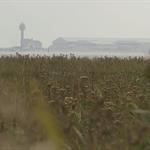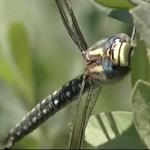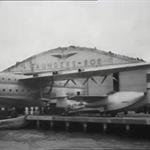-

by NFA Media ArchiveNovember 19, 2023
🎬British Pathé – CEA hold conference in Bournemouth, whilst stars attend premiere of 'Happy Go Lovely'. Item title reads - Film Chief in Conference. Bournemouth, Dorset. M/S Bournemouth, pan to sea. M/S Town Hall. M/S conference. C/U Mr Speakman. C/U Harry Mears. M/S CEA conference. M/S crowd outside Westover Cinema for world premiere of 'Happy Go Lovely'. M/S women programme sellers entering theatre. Various shots crowds in foyer. M/S as Sir Philip Warter greets Councillor and Mrs Mears. M/S Patricia Dainton and Kieron Moore being greeted by Sir Philip Warter and others. C/U Pat shaking hands with Mrs Mears. M/S Joan Dowling talking into microphone outside cinema. M/S Philip Warter and others greeting mayor and mayoress of Bournemouth. M/S mayor and mayoress being greeted by Mears and his wife. M/S crowd in foyer. C/U George Robey shaking hands with Sir Philip Warter and Mr David Goodlatte. M/S crowd. M/S George walking away from executives.
3798 Views
-

by NFA Media ArchiveNovember 21, 2023
🎬Roger Finn explores a remote part of Hampshire to see the wildlife and discover its unusual neighbor.
For Roger, this is an exclusive visit to what is probably the south's best protected wildlife habitat. Thousands of people see it from afar every day, but very few are allowed into the saltmarshes at Fawley Power Station.
Alison Jones, Fawley’s Community Affairs Manager, said: “We have worked incredibly hard over the years to not only protect our environment but to actively help it flourish. The saltmarsh and the reservoir are wonderful examples of how this care and effort has paid off. To be asked to feature in Finn’s Country was a great opportunity for us to share this work with the wider public.”
A BBC South Today Feature
8663 Views
-

by NFA Media ArchiveNovember 21, 2023
🎬Roger Finn goes in search of Dragonflies in the New Forest. Doug Overton guides Roger through the delicate world of dragonfly spotting. Over half of the UK's forty dragonfly species can be found in the New Forest.
Identified Species:
Damselfly
Hairy dragonfly
Golden-ringed dragonfly
Broad-bodied chaser
Large red damselfly
Southern damselfly
A BBC South Today Feature
Find out more here:
https://newforestdragonflies.com/
8542 Views
-

by NFA Media ArchiveNovember 21, 2023
🎬Roger Finn presents a short documentary about Aldo Galli who illustrated Watership Down.
Aldo graduated from Agricultural Sciences at the University of Milan in 1992 and moved to England in 2001.
"Creating the Watership Down collection was, without doubt, a unique experience and a great satisfaction. Quite possibly, it was the final development of an idea that I had unconsciously carried in the back of my mind since my childhood, when a Christmas I received as a present a novel that told the story of a band of rabbits…." Aldo Galli.
A BBC South Today Feature
8456 Views
-

by NFA Media ArchiveOctober 25, 2023
🎬British Pathé – First lawn tennis tournament open to amateur and professionals - lots of tennis stars attend. No title. First open lawn tennis tournament at Bournemouth, Dorset for amateur and professional players. L/S tennis matches in progress on row of courts. Various shots tennis player Peter Curtis and Fred Stolle playing game. Panning shot tennis player Christine Truman arriving. Panning shot tennis player Bobby Wilson. C/U tennis player Stanley Matthews Jnr. M/S group of young players. C/U tennis player John Paish. M/S tennis player O. K. Davidson looking at programme. C/U ditto. Various shots tennis player Virginia Wade signing autographs for group of schoolgirls. M/S tennis player Angela Mortimer with fashion designer Teddy Tinling. C/U ditto (Tinling is wearing unusual collarless shirt and necklace!) C/U tennis player Angela Mortimer. Various shots match between Mrs. P.M. Roberts (tennis player Margaret Roberts) and Virginia Wade on the centre court
3729 Views
-

by NFA Media ArchiveNovember 19, 2023
🎬British Pathé – Item title reads - Flying Boats for sale. Out of date Princess Flying Boats for sale. Calshot, Hampshire. Various shots of the Princess flying boats on slipway, M/S scaffolding on tail. Various shots of the flying boats. Various shots from 1952 of one of the flying boats being manoeuvred into the water at Cowes, Isle of Wight. People run to watch. Various shots of the boat in the water
3737 Views
Update Required
To play the media you will need to either update your browser to a recent version or update your

Processing Video - Please Wait!

Processing Video - Please Wait!

Processing Video - Please Wait!
Update Required
To play the media you will need to either update your browser to a recent version or update your
Update Required
To play the media you will need to either update your browser to a recent version or update your
🎬British Pathé – CEA hold conference in Bournemouth, whilst stars attend premiere of 'Happy Go Lovely'. Item title reads - Film Chief in Conference. Bournemouth, Dorset. M/S Bournemouth, pan to sea. M/S Town Hall. M/S conference. C/U Mr Speakman. C/U Harry Mears. M/S CEA conference. M/S crowd outside Westover Cinema for world premiere of 'Happy Go Lovely'. M/S women programme sellers entering theatre. Various shots crowds in foyer. M/S as Sir Philip Warter greets Councillor and Mrs Mears. M/S Patricia Dainton and Kieron Moore being greeted by Sir Philip Warter and others. C/U Pat shaking hands with Mrs Mears. M/S Joan Dowling talking into microphone outside cinema. M/S Philip Warter and others greeting mayor and mayoress of Bournemouth. M/S mayor and mayoress being greeted by Mears and his wife. M/S crowd in foyer. C/U George Robey shaking hands with Sir Philip Warter and Mr David Goodlatte. M/S crowd. M/S George walking away from executives.
🎬Roger Finn explores a remote part of Hampshire to see the wildlife and discover its unusual neighbor.
For Roger, this is an exclusive visit to what is probably the south's best protected wildlife habitat. Thousands of people see it from afar every day, but very few are allowed into the saltmarshes at Fawley Power Station.
Alison Jones, Fawley’s Community Affairs Manager, said: “We have worked incredibly hard over the years to not only protect our environment but to actively help it flourish. The saltmarsh and the reservoir are wonderful examples of how this care and effort has paid off. To be asked to feature in Finn’s Country was a great opportunity for us to share this work with the wider public.”
A BBC South Today Feature
🎬Roger Finn goes in search of Dragonflies in the New Forest. Doug Overton guides Roger through the delicate world of dragonfly spotting. Over half of the UK's forty dragonfly species can be found in the New Forest.
Identified Species:
Damselfly
Hairy dragonfly
Golden-ringed dragonfly
Broad-bodied chaser
Large red damselfly
Southern damselfly
A BBC South Today Feature
Find out more here:
https://newforestdragonflies.com/
🎬Roger Finn presents a short documentary about Aldo Galli who illustrated Watership Down.
Aldo graduated from Agricultural Sciences at the University of Milan in 1992 and moved to England in 2001.
"Creating the Watership Down collection was, without doubt, a unique experience and a great satisfaction. Quite possibly, it was the final development of an idea that I had unconsciously carried in the back of my mind since my childhood, when a Christmas I received as a present a novel that told the story of a band of rabbits…." Aldo Galli.
A BBC South Today Feature
🎬British Pathé – First lawn tennis tournament open to amateur and professionals - lots of tennis stars attend. No title. First open lawn tennis tournament at Bournemouth, Dorset for amateur and professional players. L/S tennis matches in progress on row of courts. Various shots tennis player Peter Curtis and Fred Stolle playing game. Panning shot tennis player Christine Truman arriving. Panning shot tennis player Bobby Wilson. C/U tennis player Stanley Matthews Jnr. M/S group of young players. C/U tennis player John Paish. M/S tennis player O. K. Davidson looking at programme. C/U ditto. Various shots tennis player Virginia Wade signing autographs for group of schoolgirls. M/S tennis player Angela Mortimer with fashion designer Teddy Tinling. C/U ditto (Tinling is wearing unusual collarless shirt and necklace!) C/U tennis player Angela Mortimer. Various shots match between Mrs. P.M. Roberts (tennis player Margaret Roberts) and Virginia Wade on the centre court
🎬British Pathé – Item title reads - Flying Boats for sale. Out of date Princess Flying Boats for sale. Calshot, Hampshire. Various shots of the Princess flying boats on slipway, M/S scaffolding on tail. Various shots of the flying boats. Various shots from 1952 of one of the flying boats being manoeuvred into the water at Cowes, Isle of Wight. People run to watch. Various shots of the boat in the water